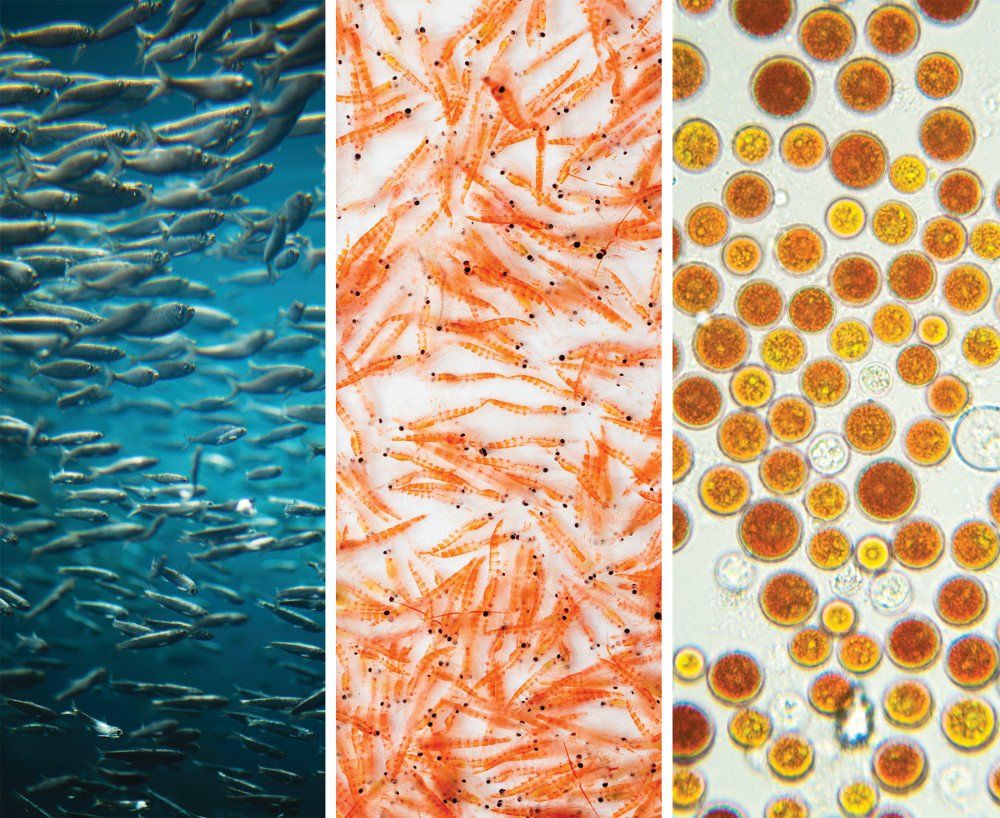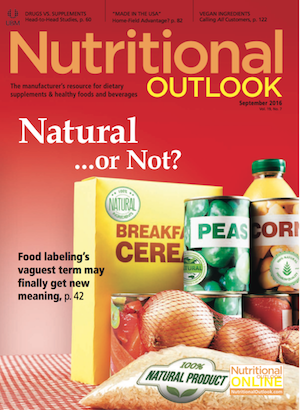2016 Omega-3 Market Update: Fish Oil, Krill Oil, Astaxanthin, and More
Omega-3 ingredient innovations are bringing life back to a market still in recovery.
Photo © iStockphoto.com. Edited by Quinn Williams.

The omega-3 market has had its share of obstacles in recent years: sales slumps, some negative publicity, and reliance on variable fish stocks. But industry pushes on. Sales are finally starting to grow again, albeit not yet to the levels seen during the ingredient’s heyday. The Global Organization for EPA and DHA Omega-3s (GOED; Salt Lake City) even went so far, as of this June, to predict 5% global growth-and even double-digit growth in Asia-through 2017.
Total growth will likely come from a combination of industry innovation and regulatory changes, both of which are ongoing around the world. Luckily, there’s exciting news in just about every corner of the omega-3 market, and there’s certainly more to come before year’s end.
Fish Oil
Fish oil makes up a majority of omega-3 product sales. Changes in the fish oil market are happening both internationally and nationally.
While the Peruvian anchoveta (Engraulis ringens) has historically been the world’s most-caught fish, this year marks the first time since 1998 that anchoveta is not the top-ranked species. According to the FAO’s latest State of World Fisheries and Aquaculture report (SOFIA)1, the title now belongs to the Alaskan pollock (Theragra chalcogramma). Industry experts believe this shift is largely due to environmental impacts of El Niño, which are worse on Peruvian anchoveta than they are on Alaskan pollock. (It’s worth noting, though, that the anchoveta population has bounced back from El Niño weather before.)
Setting aside the question of which fish species reigns supreme, industry members are actively lobbying for regulatory improvements to benefit fish oil of all major species. An FDA qualified health claim for omega-3s and blood pressure has been pending in the U.S. for years. Latest reports from GOED, which filed the original request, indicate the wait continues. The association says that on July 29, FDA requested (for the sixth time) to delay its response, this time for 180 days more until January 27, 2017.
The potential awarding of a health claim could, of course, dramatically influence omega-3 sales locally. Earlier this year, Canada approved a food health claim for omega-3 EPA and DHA for lowering triglycerides, and GOED has modest expectations for growth in that market, led by clinical and medical foods.
Though the omega-3 markets in the U.S. and Canada differ in size, the combined industries await a regulatory update that could benefit both countries: the creation of dietary reference intakes (DRIs). GOED petitioned the U.S. and Canadian governments for omega-3 EPA/DHA DRIs back in the summer of 2013. For now, two non–omega-3 ingredients, sodium and potassium, are proposed for DRI reviews in fall 2017. If EPA and DHA are next up for review, that could lead to omega-3 DRIs, which would serve as a basis for nutrient content claims-a huge opportunity for the omega-3 industry.
Globally, omega-3 suppliers also await Codex’s upcoming fish oil standard, which would also apply to krill oil. The current language, however, is considered problematic based on, among other things, a potential total arsenic limit that industry argues doesn’t take into consideration the fact that organic arsenic should be treated differently from inorganic arsenic present in omega-3 oils.
While lobbyists and government bodies continue to hash out guidance and laws, fish oil harvesters and manufacturers have taken matters into their own hands with various efforts to improve the efficiency and safety of their products. Last year, for instance, ingredient supplier Organic Technologies (Coshocton, OH) set a total oxidation limit of 5 for its entire AlaskOmega Alaskan Pollock fish oil line-a threshold that outperforms the industry standard. A fresher oil translates into better sensory characteristics for a more stable and appealing product, the company says.
“The feedback from our customers has been really positive,” says Steve Dillingham, global director, AlaskOmega ingredients. “We have experienced a significant increase in AlaskOmega customers wanting to co-brand their finished products with the AlaskOmega trademark to promote the quality of the omega-3 ingredient.”
Other suppliers are innovating to pack more EPA and DHA omega-3 fatty acids into a single dose. FMC/EPAX (Sandvika, Norway), DSM Nutritional Products (Parsippany, NJ), and BASF (Florham Park, NJ) all introduced ultra-high concentrates last year.
Still others are hoping to capture new sales through appealing delivery systems. Glanbia Nutritionals (Fitchburg, WI) and SternVitamin (Ahrensburg, Germany) now offer omega-3 powders suitable for tablets and other delivery formats beyond soft gels alone, with high stability and no fishy burps. Cargill (Minneapolis) continues its sales of IngreVita, a stable oil blending high-oleic canola oil, fish oil, and antioxidants, suited for a wide range of food and beverage applications. And Dillingham says Organic Technologies is seeing increased demand for its omega-3 triglyceride concentrates for use in liquid products.
Because marine omega-3 oils have unique qualities, Capsugel (Morristown, NJ) offers a portfolio of encapsulation platforms specifically suited for these oils, including fish and krill oil. Its Licaps OceanCaps capsules allow for the manufacture of an all-marine product, as they’re made with fish ingredients-“high-quality, farmed-fish gelatin, a renewable resource,” the firm says.
STORY CONTINUES ON PAGE 2
Krill Oil
Although krill oil sales pale in comparison to those of fish oil, krill oil’s market share is growing significantly. Aker BioMarine (Oslo, Norway), which harvests and processes Antarctic krill (Euphausia superba) in the Southern Ocean, says this single species now accounts for 20% of the omega-3 market globally, with consumer awareness at an all-time high.
There are numerous players in the Antarctic krill–fishing industry, but none bigger than Aker, which harvested more than 60% of last year’s total catch, according to the company. The Norwegian company is responsible for much of the innovation that’s improving krill oil as we know it-the latest being a new low-temperature fractionation method, dubbed Flexitech, that allows the company to better concentrate krill oil’s phospholipids and omega-3s, while at the same time removing the salts that negatively impact krill oil’s flavor and odor.
Using Flexitech, the company rolled out Superba 2 last year, the next generation of its flagship Superba krill oil, with better sensory and processing benefits. And at the Vitafoods Europe trade show this year, Aker introduced Superba Boost Caps, its first krill oil concentrate containing higher amounts of phospholipids, choline, and omega-3s, enabling potent doses in fewer capsules, which should especially benefit consumers who want (or are instructed by their physicians) to purchase high-dose omega-3 products. Manufacturers in the UK will be the first to benefit from these high doses. Recent Novel Foods approval, specific to Aker, lets UK manufacturers formulate krill oil extract products at doses of up to 3000 mg of omega-3 EPA and DHA. Other krill oil ingredients are still limited to 250 mg, the firm says.
Krill’s achievements are picking up in the human health market, but other sectors are also busy with this small crustacean. Lena Burri, Aker’s director of research and development for animal nutrition and health, says that partial replacement of fish feed with krill meal can help fish and shrimp farmers overcome palatability problems associated with feeds such as soybean meal-without adding costs. Limited research suggests that partial replacement with krill might even promote greater fish growth and shrimp growth2. These are extra signs that krill can successfully penetrate a market where its direct competitor is fish (in this case, fish meal).
While Aker is spearheading many developments with krill, other European companies are very much involved, including Rimfrost (Ã lesund, Norway), which introduced an ultra-high-phospholipid krill oil, and Enzymotec (Migda HaEmeq, Israel), which is now promoting low-sodium krill oil. And because a burgeoning krill oil market exists in China, the world’s second-largest consumer market, the country is working to build up its own krill fishery and harvest operations3.
The perceived abundance of krill is one of its strongest selling points, compared to fish, and major players in the krill industry are still trying to uphold that idea with the help of independent conservation researchers, non-profit organizations, and the Commission for the Conservation of Antarctic Marine Living Resources (CCAMLR) that helps monitor the krill population and sets yearly fishing quotas. In October 2016, CCAMLR will review the latest krill-fishing data to determine if any changes to conservation measures are necessary.
According to Jon Corsiglia, media manager, USA, for fishery certifier the Marine Stewardship Council (MSC), Antarctic krill operations are still well within their quotas. “The population of krill in the fishery area is estimated at 62 million metric tons,” he says. “The total catch currently allowed from the entire fishery area is 1% of the population size. In 2014, less than half of the total 1% catch allowance was harvested by all krill-fishing vessels in the Antarctic. By any measure, these are extremely small catches of a very large krill population.”
MSC continues to expand its fishery-certification and seafood-labeling programs. “The blue MSC ecolabel assures consumers that the krill oil product they buy originates from a sustainable fishery,” Corsiglia says. He adds that two Antarctic krill fisheries now bear MSC certification, “which demonstrates that they are operating to the highest standards of environmental sustainability in order to protect the unique ecosystems and species in the Southern Ocean.”
Astaxanthin
Whether marine- or land-derived, algae continue to expand in the health market and assume a lot of market share. Perhaps most notable among them is Haematococcus pluvialis, a microalga better known for astaxanthin, a red pigment and antioxidant that
it produces.
While astaxanthin is already a well-established commodity, suppliers believe there is room for growth now that production is ramping up. Barrington Nutritionals (Bountiful, UT), a distributor for Algatechnologies (Kibbutz Ketura, Israel), says that a previous shortage of astaxanthin compelled its supplier to improve its production capacity. Unsurprisingly, other astaxanthin growers have been working on their production capacity, too-and quantity isn’t all that these companies are concerned with. Earlier this year, BGG (Irvine, CA) obtained organic certification for its AstaZine astaxanthin farm, making it the first farm to offer certified-organic astaxanthin.
Although organic certification is a big achievement for astaxanthin, the promotion of natural has taken more prominence of late, as suppliers of natural astaxanthin attempt to distinguish themselves from suppliers of nature-identical, synthetic astaxanthin. The Natural Algae Astaxanthin Association (NAXA), composed of natural-astaxanthin producers, is actively working to communicate and elucidate what it says are drawbacks of synthetic astaxanthin, such as an alleged lack of safety testing and inferior quality.
Demand for astaxanthin is certainly global at this stage, and that’s evident in recent marketing efforts by AstaReal Inc. (Burlington, NJ) alone. The company has astaxanthin marketing offices in five countries and is planning to expand into several more international regions. In Canada in particular, AstaReal is witnessing an increase in sales thanks to a handful of recently approved Canadian health claims for AstaReal astaxanthin, including “source of/provides antioxidants,” “helps to improve muscle endurance,” and “helps to support eye health.”
With a steady supply of supporting research, astaxanthin is carving a space for itself in sports nutrition and skin care, among other human health markets. It’s also used as a natural colorant in a growing farmed-fish industry, as well as in human foods and drinks as part of a greater carotenoid family (including beta-carotene, lycopene, and others) that’s now estimated to be valued at $1.24 billion4.
STORY CONTINUES ON PAGE 3
Farmed Fish
As wild fisheries often deal with uncertainties in their fish stocks, aquaculture continues to grow in market share. The FAO predicts that farmed fish will account for 52% of fish consumed by 2025, up from the most recent estimate (44% for 2013–2015).
The move towards aquaculture should benefit the astaxanthin market, but whether it will impact fish oil is unclear. Some aquaculture operations already replace fish feed with terrestrial feeds such as soybean oil, resulting in farmed fish with, albeit, inferior omega-3 levels5; on the other hand, this presents an opportunity for algae supplementation, which can bolster omega-3 levels sustainably.
In partnership with Bunge Ltd. (White Plains, NY), TerraVia (San Francisco), which also supplies algae ingredients for human food, is making available a DHA-rich algae product intended for aquaculture. It’s a shortcut to optimum omega-3 nutrition because it’s sourced from the very algae that provide fish with their natural omega-3 levels in the wild-only now it’s made in fermentation tanks and sent to aquaculture farms that don’t pull resources from the ocean. The two companies are confident that growing fish oil demand, coupled with the risk of wild-caught fish, will create continued opportunities for the novel algal feed, which contains almost twice the level of DHA found in conventional fish oil.
Sidebar: Fish Roe
The market for fish roe in dietary supplements is still fairly small, but a handful of companies are moving forward with this alternative to fish oil anyway.
Arctic Nutrition AS (Ãrsta, Norway) has its Romega brand, which was recently validated as a well-tolerated source of EPA and DHA that may improve lipid profiles. Meanwhile, Valensa International (Eustis, FL) recently introduced a Deep Ocean Caviar complete with herring roe (pictured) and added astaxanthin and perilla seed oil. Valensa’s combination product benefits from phospholipid-bound EPA and DHA, and supplementary omega-3 ALA from perilla seed oil, which can be converted by the body into EPA and DHA. The addition of astaxanthin gives this otherwise yellow oil a red tinge without the potential of shellfish allergy that exists with krill oil.
Sidebar: Miniature Shrimp Oil
If marine omega-3 sources weren’t plentiful enough, a miniature shrimp has emerged with potential for market in the United Kingdom. It’s Calanus finmarchicus, one of the most abundant zooplankton species in the North Atlantic Ocean and a frequent food for Atlantic herring and salmon.
The biomarine company Calanus AS (Tromsø, Norway) petitioned for calanus oil Novel Food status back in 2011, and the UK Food Standards Agency is now evaluating the ingredient for legal use. The agency released a draft opinion this May, detailing the ingredient’s safety record and supporting health studies.
Calanus oil is rich in DHA and EPA, but it also contains astaxanthin. If these properties sound familiar, that’s because they’re also found in krill oil. Krill and calanus are both bottom feeders, so their oils are less likely than other species to carry marine pollutants. If approved for use in the UK, and perhaps elsewhere, Calanus’s oil will be available in powder and oil formats.
Also read:
Comparing Omega-3 Bioavailability
Krill Oil Ups Share of Omega-3 Market, Aker Says
References:
- www.fao.org/3/a-i5555e.pdf
- Nunes AJP et al., “Growth performance of the white shrimp, Litopenaeus vannamei, fed on practical diets with increasing levels of the Antarctic krill meal, Euphausia superba, reared in clear- versus green-water culture tanks,” Aquaculture Nutrition. Published online September 14, 2010.
- Urch M. “Financial Constraints Put Brakes on China’s ‘Krill Project’.” www.seafoodsource.com/all-commentary/financial-constraints-put-brakes-on-china-s-krill-project
- Markets and Markets, “Carotenoids Market worth 1.53 Billion USD by 2021.” www.marketsandmarkets.com/PressReleases/carotenoid.asp
- Sprague M et al., “Impact of sustainable feeds on omega-3 long-chain fatty acid levels in farmed Atlantic salmon, 2006–2015,” Scientific Reports. Published online February 22, 2016.

Prinova acquires Aplinova to further increase its footprint in Latin America
April 7th 2025Prinova has recently announced the acquisition of Brazilian ingredients distributor Aplinova, which is a provider of specialty ingredients for a range of market segments that include food, beverage, supplements, and personal care.

























